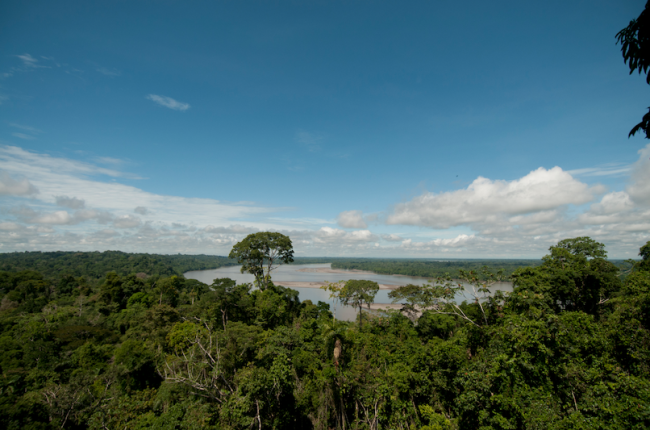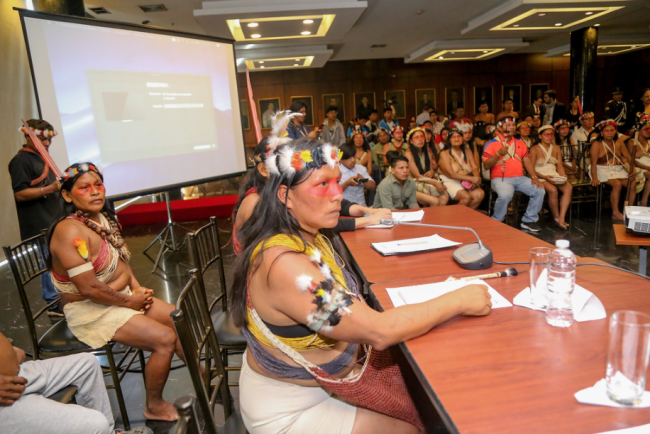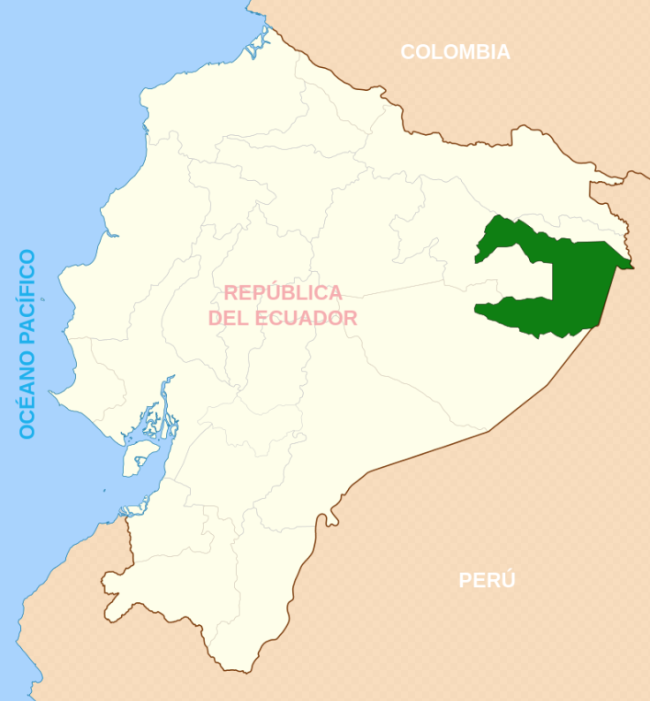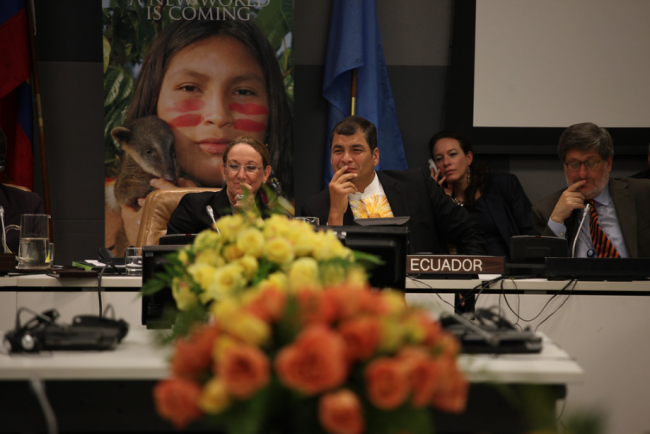
On August 20, Ecuador made history with a 59 percent vote in support of a popular referendum to stop petroleum drilling in the Yasuní National Park, one of the most biodiverse areas on the planet. “It’s an example not just for Ecuador, but for the world,” said Alexandra Almeida of Acción Ecológica, an environmental organization based in the capital of Quito.
In 2008, Ecuador became the first country to grant nature rights in its constitution. Now, in another first, Ecuadorian social movements have bypassed pro-extractivist politicians with a national referendum to keep oil from Block 43 also known as “Yasuní ITT,” a concession in the deepest part of the Amazonian protected Yasuní National Forest, in the ground. While movements around the world have successfully achieved mining moratoria, this is an important new strategy for environmental and Indigenous rights activists.
For German Ahua, president of the Organization of the Waorani Nationality of Orellana, one of three provinces home to Yasuní, the referendum result opens a new era for the well-being and future of affected Amazonian communities. “Fifty years of petroleum operations have left us in ruins,” he said, underlining health problems and a lack of economic and educational resources. “Without free, prior, and informed consent, the state has put us through many things.”
Keeping oil in the ground in Yasuní will save 410 million metric tons of greenhouse gasses— equivalent to the annual emissions of France—from entering the atmosphere. The vote marks a triumph for the country’s grassroots anti-extractivist, ecological, and Indigenous movements, whose road to victory comes from a decade of social and political conflicts over extractive industry policies. And against a backdrop of a worsening general security situation that raised particular alarm as a presidential candidate was assassinated just 10 days before the August 20 election, the environmental and Indigenous rights activists on the frontlines of that struggle operate on a terrain plagued by increased insecurity and violence.

Yasuní in the Spotlight
The Yasuní National Park is in part located in Waorani ancestral territory. It is also a unique area where South America’s richness of plant, amphibian, bird, and mammal species overlap, boasting the highest levels of biodiversity per square meter in the world. Over 150 threatened species reside there. Three Waorani groups—the Tagaeri, Taromenane, and Dugakeaeri—remain in voluntary isolation and are considered “uncontacted peoples.” Oil activity has driven illness, food insecurity, and massacres in the area.
Silvana Nihua, president of the Organization of Waorani of Pastaza, has seen the impacts firsthand. “As women, we work hard to feed our children from the forest,” she said. “Before there wasn’t this level of oil spills and landslides in the mountains and the rivers.” Since the 1950s, petroleum activity has dramatically impacted the Waorani’s food supply in addition to producing extreme social and cultural repercussions. Those living near oil wells became dependent on oil companies for food and medicine, although even those handouts haven’t always been reliable. “They make excuses to stop giving food,” Nihua said. “They don’t give food nor employment and they have ended our way of life and haven’t made reparations.”

Intensification of petroleum production with new oil concessions in the past two decades brought additional attacks on Indigenous lands and rights to Waorani communities. In 2019, following the grassroots “Our Rainforest is not for Sale” campaign led by Goldman Environmental Prize winner Nemonte Nenquimo, the Waorani won a landmark legal victory, halting extraction in Block 22. Activity in neighboring blocks continued, however. Road blockades in Waorani territory are frequent, and last year Waorani groups took over refineries surrounding the Yasuní as part of a national strike organized by the national Indigenous movement.
A History of Exploitation and Violence
Initially contacted in the 1950s by missionaries collaborating with Shell Oil, the Waorani have experienced dramatic changes in their lifetimes. Of 60,000 Waorani believed to be living in the Ecuadorian Amazon before oil exploitation, only an estimated 2,500 survived by the 1980s. Petroleum production triggered significant displacement of communities to more urbanized cities in the Amazon, fomented disunity and conflict on decision-making, and drove youth to abandon traditional territories in search of jobs.
Still uncontacted, the Tagaeri and Taromenane were pushed south by a series of oil concessions throughout the 1970s and 1980s until the “Intangible Zone of the Tagaeri-Taromenane” (ZITT) was formed by presidential decree in 1999. The decree did not remove oil concessions already in Taromenane land. Throughout the 1990s and 2000s, oil companies built roads, facilitating the entry of illegal loggers into the Yasuní National Park. Petreolum and logging interests had pressured contacted Waorani to make contact with the Tagaeri and Taromenani, resulting in a series of killings, including the burning of a house in 2003 that killed an estimated 20 people. Confrontations between uncontacted groups and loggers resulted in more deaths in 2008 when the Taromenane attacked an illegal logging camp, resulting in at least one logger killed and accounts of revenge killings perpetrated by the loggers.

According to Ameída of Acción Ecológica, violence and rights violations worsened in 2013, when the government sought to open oil extraction in Yasuní. “The Ministry of the Environment re-drew the maps, placing the territory of the uncontacted groups further south,” she explained. In the same year, confrontations resulted in an armed massacre of 20 to 30 Taromenane.
“The petroleum companies say that these are conflicts between the Wao [Waorani], but then they give the community (near the petroleum wells) everything they need to commit the murders,” said Opi Nenquimo of the Ceibo Alliance, a multi-nation Indigenous organization that organizes to defend the Amazon. Along with other Indigenous leaders, Nenquimo patrols Indigenous territory to document and remove illegal loggers and miners. Confrontations have left over 60 dead, the majority of them Tagaeri and Taromenane women and children. Recent petroleum expansions and new oil wells brought uncontacted groups close to refineries to investigate the noise and pollution that was driving away the animals they relied on for food. In April 2023, four more Waorani were killed near a new petroleum installation.
“Protected” Forest
The Yasuní has been a protected area since 1979. However, the specifics of what “protected” means has changed over time.
In 2007, President Rafael Correa launched a plan to raise over $3 billion to “protect” Block 43, renamed Yasuní ITT in reference to the Intangible Zone Tagaeri-Taromenane. Framed as a bid to offsett the value of exploiting the block through an international fund to replace lost fossil fuel revenues, the initiative was hailed a landmark plan to keep the oil in the ground. The proposed protection, however, was partial: while Yasuní ITT refers only to Block 43, several other blocks also overlap with the Intangible Zone. After wealthy nations failed to pitch in the money, Correa began plans to exploit the Yasuní National Forest. While it was illegal to mine in protected lands under the 2008 Constitution, Correa petitioned the National Assembly to declare the Yasuní an area “of national interest” and thus exempt it from constitutional protections in 2013.

Immediately, social movements formed a coalition known as the Yasunidos, gathering signatures for a national referendum on banning oil activity in Block 43. Members of Yasunidos were detained and jailed, and crackdowns on resistance left protesters injured by rubber bullets and tear gas canisters. Nearly half of the signatures they gathered were ruled inadmissible in a process Yasuindos claimed was corrupt.
After 10 years of legal battles, the courts ruled on May 9, 2023 that the Yasunidos signatures were valid, allowing for the national referendum on Block 43 to happen.
Sí al Yasuní
Just over a week after the long-awaited court decision, right-wing President Guillermo Lasso triggered snap elections. Charged with embezzlement and implicated in connections with transitional drug cartels, Lasso dissolved the National Assembly before they could impeach him, using a never-before-invoked constitutional clause known as “muerte cruzada” or mutually assured death. The early election was scheduled for August 20, with the fate of the Yasuní on the ballot.
Operating precariously between the “Correísta” politicians on the left and the economic conservatives on the right, both of which are highly invested in oil exploitation, the Yasuní “Sí” campaign brought together a wide range of popular sectors including environmental, Indigenous, feminist, youth, and student movements and collectives as well as prominent activists, intellectuals, and media personalities. Through a far-reaching grassroots and social media campaign that included marches, public art, songs, and videos under the banner #SialYasuni, the campaign effectively steered the national debate toward the dire impacts of pollution and the importance of conservation for future generations and the world.
The campaign also disputed arguments over petroleum profits and potential losses if oil is not extracted. According to Mateo Villalba, former president of Ecuador’s Central Bank, these pro-oil extraction arguments inflate amounts of lost revenues while tapping into discourses of fear. Instead, Villalba believes that keeping Yasuní’s oil in the ground would be just the “push the Ecuadorian economy needs to begin thinking [about] how to reorganize its public finances, production, and socio-political institutions for a post-petroleum future.” Even if the Yasuní were to continue to be exploited, a geological study indicated that by 2029 Ecuador’s oil reserves would be largely exhausted.
Residents of the Amazon region make up only 5 percent of Ecuador’s population, and many don’t possess the legal identification needed to vote. Yet in the final days before the referendum, Amazonian groups sent caravans to major cities to campaign for the Yasuní. Their message was clear. As Nihua put it: “Who is it that kills? It’s the extractive industries and the state…So for our children, we need to vote ‘Sí’ to the Yasuní.”
Ecuador’s historic referendum decision comes at an important crossroads. With no candidate capturing the majority, the country heads to a run-off vote in October between leftist Luisa González of Correa’s Citizens’ Revolution Party and conservative businessman Daniel Noboa. It was no small feat that the Yasuní vote succeeded in the context of a security crisis characterized by rising gang violence linked to competing narcotrafficking groups and a shocking political assassination. The referendum’s impact will shape the upcoming runoff and set a global precedent for direct democracy on approaching climate crisis and a just transition.
While the referendum is a victory, social movements and nonprofit organizations have also said they will need to be vigilant regarding its implementation. Moreover, seven other petroleum blocks encroach on the Yasuní national forest and 13 more surround it. The vote on the Yasuní came alongside a series of successful referendums protecting Chocó Andino, the Andean biosphere reserve, from mining as well.
Popular support for protecting Ecuador’s cultural and natural resources can’t be underestimated. “We have children that deserve to enjoy what we’ve enjoyed: the animals, the fish, the trees, the clean water, the waterfalls,” Nihua said. “The oil stays in the ground. This we have decided.”
Angélica María Bernal teaches politics at the University of Massachusetts-Amherst. She is the author of Beyond Origins (Oxford University Press, 2017) and editor of De la Exclusión a la Participación (Abya Yala Press, 2000). She is currently working on a book on women’s resistance and extractive politics in Ecuador.
Joshua Holst is an applied visual anthropologist specializing in globalization and conflict. He has worked for NGOs and intergovernmental organizations in West Africa, Southeast Asia, and the Americas. For more information: www.rethinkpolitics.org/joshua-holst/

